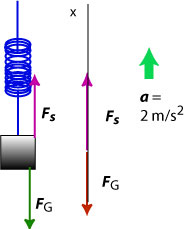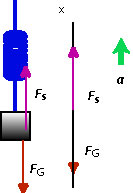Newtons Laws EX 27
(a) The acceleration of the block is zero so the sum of the forces exerted on the block is zero. There are two forces exerted on the mass, and . We choose the x-axis pointing upward. Then we draw the free body diagram

and write the equation since we don't have to compute the components:
It follows from this equation that the magnitude of the force of the spring must be equal to the magnitude of the gravitational force.
(b) The acceleration of the block is upwards (the free body diagram is below):

Since the magnitude of the force of spring is equal to
, we can compute
(c) Here we know the magnitude of the force exerted by the spring . We will assume that the acceleration points upward and draw the same diagram as in the problem above.

Solving for we find . The negative sign indicates that the mass accelerates downward.